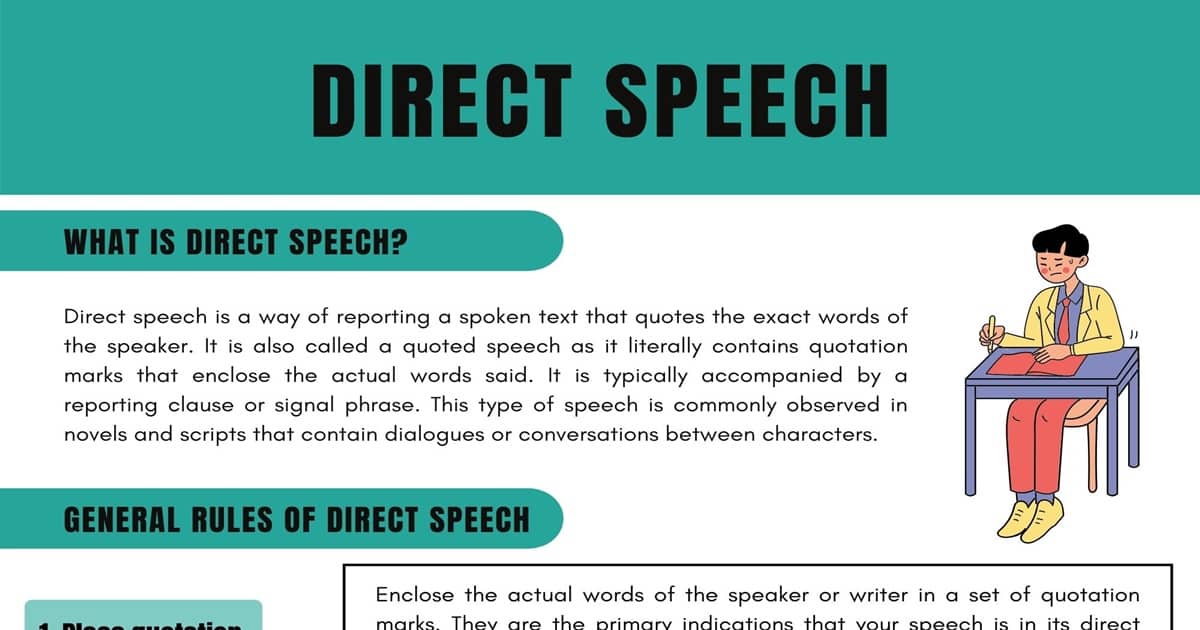In English grammar, there are generally two ways of reporting a spoken text: direct and indirect. Direct speech differs in composition compared to indirect speech. This article will discuss the definition, rules, and examples of direct speech that will help you understand how it is used in writing.
Direct Speech
What Is Direct Speech?
Direct speech is a way of reporting a spoken text that quotes the exact words of the speaker. It is also called a quoted speech as it literally contains quotation marks that enclose the actual words said. It is typically accompanied by a reporting clause or signal phrase. This type of speech is commonly observed in novels and scripts that contain dialogues or conversations between characters.
General Rules of Direct Speech
A direct speech should be written in correct composition so that it will be understood right. Here are the steps on how to do so:
1. Place quotation marks
Enclose the actual words of the speaker or writer in a set of quotation marks. They are the primary indications that your speech is in its direct form.
Examples:
- “You look familiar. Have we met before?” the woman asks.
- “I don’t think so,” I answer.
2. Use a reporting clause
You should accompany the quoted text with a reporting clause, which may be placed before or after the quoted text. A reporting clause consists of a noun or pronoun and a reporting verb or signal phrase. The first word of the reporting clause should not be capitalized if it is situated after the quoted text unless it is a proper noun.
Examples:
- “Where do you want to have lunch?” the boy asked.
- The girl answered, “I prefer eating at the cafeteria.”
Nothing that is not part of the quoted text should be enclosed in the quotation. If you plan to put the reporting clause in between two quoted text, make sure that it is not included inside any of the sets of quotation marks.
Examples:
- “You should go home,” her workmate says. “You look tired.”
- “We can continue tomorrow,” she suggests. “But we have to come to work early.”
3. Placement of comma
You should separate the reported speech from the reporting clause by a comma. If the reporting clause precedes the reported speech, you have to put the comma before the opening quotation mark. There has to be a space between the comma and the quotation.
Examples:
- He says, “I want to buy some ice cream.”
- He asks, “Do you have some ice cream?”
If the reporting clause is found after the reported speech, the comma should be placed right before the closing quotation mark. Meaning, it should be found after the last word of the quoted text.
Example:
- “I want to buy some ice cream,” he says.
However, for quoted speech ending with a question or exclamation mark, you don’t need to put a comma anymore.
Example:
- “Do you have some ice cream?” he asks.
Direct Speech Examples
Reporting clause before the reported speech
- Gina says, “I think I lost my wallet.”
- Marlon asks, “Really? Where did you last put it?”
- Gina answers, “Here, inside my bag.”
- Gina exclaims, “Oh, wait, here it is!”
Reporting clause after the reported speech
- “John, where have you been?” Jane asked.
- “I went to the nearest convenience store to buy us some snacks,” John answered.
- “Wow, thank you!” Jane exclaimed.
- “You’re welcome,” John replied.
Direct Speech | Image










0 Comments